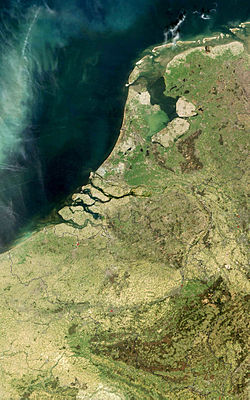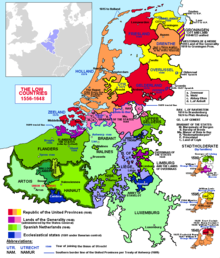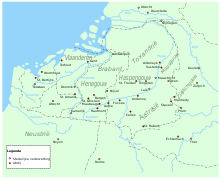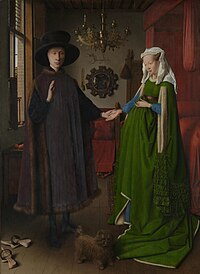Low Countries

TheLow Countries(Dutch:de Lage Landen;French:les Pays-Bas), historically also known as theNetherlands(Dutch:de Nederlanden), is a coastallowlandregion in NorthwesternEuropeforming the lowerbasinof theRhine–Meuse–Scheldt deltaand consisting today of the three modern "Benelux"countries:Belgium,Luxembourg,and theNetherlands(Dutch:Nederland,which is singular). Geographically and historically, the area can also include parts ofFranceandGermanysuch asFrench Flandersand the German regions ofEast Frisia,GueldersandCleves.During theMiddle Ages,the Low Countries were divided into numerous semi-independentprincipalities.[1][2]
Historically, the regions without access to the sea linked themselves politically and economically to those with access to form various unions of ports andhinterland,[3]stretching inland as far as parts of the GermanRhineland.Because of this, nowadays not only physically low-altitude areas, but also some hilly or elevated regions are considered part of the Low Countries, including Luxembourg and the south of Belgium. Within theEuropean Union,the region's political grouping is still referred to as theBenelux(short for Belgium-Netherlands-Luxembourg).
During theRoman Empire,the region contained a militarised frontier and contact point betweenRomeandGermanic tribes.[4]The Low Countries were the scene of the early independent trading centres that markedthe reawakeningof Europe in the 12th century. In that period, they rivallednorthern Italyas one of the most densely populated regions of Western Europe.Guildsand councils governed most of the cities along with afigureheadruler; interaction with their ruler was regulated by a strict set of rules describing what the latter could and could not expect. All of the regions mainly depended on trade, manufacturing and the encouragement of the free flow of goods and craftsmen.[5]DutchandFrenchdialects were the main languages used in secular city life.
Terminology[edit]


Historically,the termLow Countriesarose at the Court of theDukes of Burgundy,who used the termles pays de par deçà( "the lands over here" ) for the Low Countries as opposed toles pays de par delà( "the lands over there" ) for theDuchy of Burgundyand theFree County of Burgundy,which were part of their realm but geographically disconnected from the Low Countries.[6][7]GovernorMary of Hungaryused both the expressionsles pays de par deçaandPays d'Embas( "lands down here" ), which evolved toPays-BasorLow Countries.Today the term is typically fitted to modern political boundaries[8][9]and used in the same way as the termBenelux.
The name of the country of theNetherlandshas the same etymology and origin as the name for the region Low Countries, due to "nether" meaning "low".[10]In the Dutch language itselfDe Lage Landenis the modern term for Low Countries, andDe Nederlanden(plural) is in use for the 16th century domains ofCharles V,the historic Low Countries, whileNederland(singular) is the normal Dutch name for the country of the Netherlands. However, in official use, the name of the Dutch kingdom is stillKingdom of the Netherlands,Koninkrijk der Nederlanden(plural). This name derives from the 19th-century origins of the kingdom which originally included present-day Belgium.
In Dutch, and to a lesser extent in English, the Low Countries colloquially means the Netherlands and Belgium, sometimes the Netherlands andFlanders—the Dutch-speaking north of Belgium. For example, aLow Countries derby(Derby der Lage Landen), is a sports event between Belgium and the Netherlands.
Belgiumseparated in 1830 from the (northern) Netherlands. The new country took its name fromBelgica,theLatinisedname for the Low Countries, as it was known during theEighty Years' War(1568–1648). The Low Countries were in that war divided in two parts. On one hand, the northernFederated NetherlandsorBelgica Foederatarebelled against KingPhilip II of Spain;on the other, the southernRoyal NetherlandsorBelgica Regiaremained loyal to the Spanish king.[11]This divide laid the early foundation for the later modern states of Belgium and the Netherlands.
History[edit]
The region politically had its origins in theCarolingian empire;more precisely, most of the people were within the Duchy ofLower Lotharingia.[12][13]After the disintegration of Lower Lotharingia, the Low Countries were brought under the rule of various lordships until they came to be in the hands of theValois Dukes of Burgundy.Hence, a large part of the Low Countries came to be referred to as theBurgundian Netherlands.After the reign of the Valois Dukes ended, much of the Low Countries were controlled by theHouse of Habsburg.This area was referred to as theHabsburg Netherlands,which was also called theSeventeen Provincesup to 1581. Even after the politicalsecessionof the autonomousDutch Republic(or "United Provinces" ) in the north, the term "Low Countries" continued to be used to refer collectively to the region. The region was temporarily united politically between 1815 and 1839, as theUnited Kingdom of the Netherlands,before this split into the three modern countries of the Netherlands, Belgium and Luxembourg.
Early history[edit]
The Low Countries were part of theRomanprovinces ofGallia BelgicaandGermania Inferior.They were inhabited byBelgicandGermanic tribes.In the 4th and 5th century,Frankishtribes had entered this Roman region and came to run it increasingly independently. They came to be ruled by theMerovingian dynasty,under which dynasty the southern part (below theRhine) was re-Christianised.
Frankish empire[edit]
By the end of the 8th century, the Low Countries formed a core part of a much expandedFranciaand the Merovingians were replaced by theCarolingian dynasty.[14]In 800, the Pope crowned and appointedCharlemagneEmperorof the re-establishedRoman Empire.
After the death ofCharlemagne,Francia was divided in three parts among his three grandsons.[15]The middle slice,Middle Francia,was ruled byLothair I,and thereby also came to be referred to as "Lotharingia" or "Lorraine". Apart from the original coastalCounty of Flanders,which was withinWest Francia,the rest of the Low Countries were within the lowland part of this, "Lower Lorraine".
After the death of Lothair, the Low Countries were coveted by the rulers of bothWest FranciaandEast Francia.Each tried to swallow the region and to merge it with their spheres of influence. Thus, the Low Countries consisted offiefswhose sovereignty resided with either theKingdom of Franceor theHoly Roman Empire.While the further history the Low Countries can be seen as the object of a continual struggle between these two powers, the title ofDuke of Lothierwas coveted in the low countries for centuries.[16]
Duchy of Burgundy[edit]
In the 14th and 15th century, separate fiefs came gradually to be ruled by a single family throughroyal intermarriage.This process culminated in the rule of theHouse of Valois,who were the rulers of theDuchy of Burgundy.At the height of Burgundian influence, the Low Countries became the political, cultural, and economic centre ofNorthern Europe,noted for its crafts and luxury goods, notablyearly Netherlandish painting,which is the work of artists who were active in the flourishing cities ofBruges,Ghent,Mechelen,Leuven,TournaiandBrussels,all in present-day Belgium. Musicians of theFranco-Flemish Schoolwere highly sought by the leading classes of all Europe.

Seventeen Provinces[edit]
In 1477 theBurgundian holdingsin the area passed through an heiress—Mary of Burgundy—to theHabsburgs.Charles V, who inherited the territory in 1506, was named ruler by theStates Generaland styled himself asHeer der Nederlanden(lit. 'Lord of the Netherlands'). He continued to rule the territories as a multitude of duchies and principalities until the Low Countries were eventually united into one indivisible territory, theSeventeen Provinces,covered by thePragmatic Sanction of 1549,[17]while retaining existing customs, laws, and forms of government within the provinces.[18]
The Pragmatic Sanction transformed the agglomeration of lands into a unified entity, of which theHabsburgswould be the heirs. By streamlining the succession law in all Seventeen Provinces and declaring that all of them would be inherited by one heir, Charles effectively united the Netherlands as one entity. After Charles' abdication in 1555, the Seventeen Provinces passed to his son,Philip II of Spain.[19]
Division[edit]
The Pragmatic Sanction is said to be one example of the Habsburg contest withparticularismthat contributed to theDutch Revolt.Each of the provinces had its own laws, customs and political practices. The new policy, imposed from the outside, angered many inhabitants, who viewed their provinces as distinct entities. It and other monarchical acts, such as the creation of bishoprics and promulgation of laws againstheresy,stoked resentments, which fired the eruption of theDutch Revolt.[20]
After the northernSeven United Provincesof the seventeen declared their independence fromHabsburg Spainin 1581, the ten provinces of theSouthern Netherlandsremained occupied by theArmy of Flandersunder Spanish service and are therefore sometimes called theSpanish Netherlands.In 1713, under theTreaty of Utrechtfollowing theWar of the Spanish Succession,what was left of the Spanish Netherlands was ceded toAustriaand thus became known as theAustrian Netherlands.
-
Kenau Simonsdochter Hasselaerdefending the walls during theSiege of Haarlem(1572–1573)
-
Sack ofMaastrichtby theTercios de Flandes(Flemish Regiments) in 1579
-
Siege and capture ofTournai(1581)
-
Map ofOstendduring thesiege in 1601
Late Modern Period[edit]
TheUnited Kingdom of the Netherlands(1815–1830) temporarily united the Low Countries again before it split into the three modern countries of the Netherlands, Belgium and Luxembourg.
During the early months ofWorld War I(around 1914), theCentral Powersinvaded the Low Countries ofLuxembourgandBelgiumin what has been come to be known as theGerman invasion of Belgium.It led to the German occupation of the two countries. However, the German advance intoFrancewas quickly halted, causing a military stalemate for most of the war. In the end, a total of approximately 56,000 people were killed in the invasion.[21]
DuringWorld War II,whenAdolf Hitler's gaze turned his strategy west toward France, the Low Countries were an easy route around the imposing FrenchMaginot Line.He ordered a conquest of the Low Countries with the shortest possible notice, to forestall the French, and preventAlliedair powerfrom threatening the strategicRuhr Area[vague]of Germany.[22]It would also provide the basis for a long-term air and sea campaign against Britain. As much as possible of the border areas in northern France should be occupied.[23]Germany'sBlitzkriegtactics rapidly overpowered the defences of Belgium, the Netherlands and Luxembourg.
All three countries were occupied from May 1940 until early 1945. During the occupation, their governments were forced into exiled in Britain. In 1944, they signed theLondon Customs Convention,laying the foundation for the eventualBenelux Economic Union,[24]an important forerunner of theEEC(later theEU).[25]
Literature[edit]
One of the Low Countries' earliest literary figures is the blind poetBernlef,fromc. 800,who sang both Christianpsalmsand pagan verses. Bernlef is representative of the coexistence ofChristianityandGermanic polytheismin this time period.[26]: 1–2
The earliest examples of written literature include theWachtendonck Psalms,a collection of twenty five psalms that originated in the Moselle-Frankish region around the middle of the 9th century.[26]: 3
See also[edit]
- Burgundian Circle
- Burgundian Netherlands
- Early Netherlandish painting
- Greater Netherlands
- Lower Lorraine
- Pan-Netherlands
- Union of Brussels
References[edit]
Citations[edit]
- ^"Low Countries".Encyclopædia Britannica.Encyclopædia Britannica, Inc.Retrieved26 January2014.
- ^"Low Countries – definition of Low Countries by the Free Online Dictionary, Thesaurus and Encyclopedia".Farlex, Inc.Retrieved26 January2014.
- ^Matei-Chesnoiu, Monica (2012).Re-imagining Western European Geography in English Renaissance Drama.Palgrave Macmillan. p. 105.ISBN9780230366305.
- ^Turner, Barry (2010).The Statesman's Yearbook 2011: The Politics, Cultures and Economies of the World.Springer. p. 908.ISBN9781349586356.
- ^Braudel, Fernand (1992).Civilization and Capitalism, 15th–18th Century, Vol. III: The Perspective of the World.University of California Press. p. 98.ISBN9780520081161.
- ^"1. De landen van herwaarts over"(in Dutch). Vre.leidenuniv.nl. Archived fromthe originalon 13 May 2016.Retrieved1 January2014.
- ^Alastair Duke."The Elusive Netherlands. The question of national identity in the Early Modern Low Countries on the Eve of the Revolt".Retrieved1 January2014.
- ^"Low Countries".TheFreeDictionary.com.
- ^"Low Countries | region, Europe".Encyclopedia Britannica.31 May 2023.
- ^"Netherlands".Origin & meaning of Netherlands by Online Etymology Dictionary.etymonline.com.
- ^Buys, Ruben (2015).Sparks of Reason: Vernacular Rationalism in the Low Countries, 1550–1670.Uitgeverij Verloren. p. 17.ISBN9789087045159.
- ^"Franks".Columbia Encyclopedia.Columbia University Press.2013.Retrieved1 February2014.
- ^"Lotharingia / Lorraine (Lothringen)".5 September 2013.Retrieved1 February2014.
- ^Ramirez-Faria, Carlos (2007).Concise Encyclopeida of World History.Atlantic Publishers & Dist. p. 683.ISBN9788126907755.
- ^Chopra, Hardev Singh (1974).De Gaulle and European Unity.Abhinav Publications. p. 131.ISBN9780883862889.
- ^Jeep, John M. (2017).Routledge Revivals: Medieval Germany (2001): An Encyclopedia.Routledge. pp. 291–295.ISBN9781351665391.
- ^"History of Luxembourg: Primary Documents".EuroDocs.Retrieved10 September2017.
- ^Limm, P. (2014).The Dutch Revolt 1559–1648.Routledge.ISBN9781317880585.Retrieved20 October2018.
- ^Ronald, Susan (2012).Heretic Queen: Queen Elizabeth I and the Wars of Religion.St. Martin's Press.ISBN9781250015211.Retrieved20 October2018.
- ^State, Paul F. (2008).A Brief History of the Netherlands.Infobase Publishing. p. 46.ISBN9781438108322.Retrieved20 October2018.
- ^Great Britain. War Office (14 April 2018)."Statistics of the military effort of the British Empire during the Great War, 1914–1920".London H.M. Stationery Off.Retrieved14 April2018– via Internet Archive.
- ^Frieser 2005, p. 74.
- ^"Directive No. 6 Full Text".Retrieved5 December2015.
- ^Yapou, Eliezer (1998). "Luxembourg: The Smallest Ally".Governments in Exile, 1939–1945.Jerusalem. Archived fromthe originalon 23 October 2012.
{{cite book}}:CS1 maint: location missing publisher (link) - ^Park, Jehoon; Pempel, T. J.; Kim, Heungchong (2011).Regionalism, Economic Integration and Security in Asia: A Political Economy Approach.Edward Elgar Publishing. p. 96.ISBN9780857931276.
- ^abHermans, Theo, ed. (2009).A literary history of the Low Countries.Rochester, NY: Camden House.ISBN9781571132932.
Sources[edit]
- Paul Arblaster.A History of the Low Countries.Palgrave Essential Histories Series New York:Palgrave Macmillan,2006. 298 pp.ISBN1403948283.
- J. C. H. Blom and E. Lamberts, eds.History of the Low Countries(1999)
- B. A. Cook.Belgium: A History(2002)
- Jonathan Israel.The Dutch Republic: Its Rise, Greatness, and Fall 1477–1806(1995)
- Oscar Gelderblom.Cities of Commerce: The Institutional Foundations of International Trade in the Low Countries, 1250–1650(Princeton University Press, 2013) 293 pp.
- J. A. Kossmann-Putto andE. H. Kossmann.The Low Countries: History of the Northern and Southern Netherlands(1987)
- The Cinema of the Low Countries
- Early Modern Women in the Low Countries
- The Reformation and Revolt in the Low Countries
External links[edit]
 Media related toLow Countriesat Wikimedia Commons
Media related toLow Countriesat Wikimedia Commons







